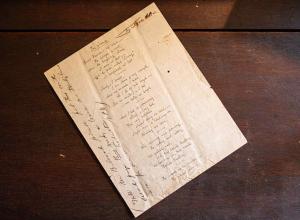Miniature Books at Grolier Club put on a Mighty Show
Though the barometer may suggest otherwise, one of the telltale signs of spring in New York is the annual arrival of Rare Book Week, going on now through March 12. Besides the various pearls for sale among the well-stocked stacks at the three book and ephemera fairs, holding court around Manhattan are a slew of shows and exhibitions dedicated to celebrating the people and things of the book world. One that serious bibliophiles should not miss is the Grolier Club's exhibition of Pat Pistner's miniature bindings and books, now on view in the second floor gallery.
The 275-item installation--a misleading number, given that some items, like the 42-volume set of Sherlock Holmes mysteries is counted as one piece--spans the history of texts written on a diminutive scale. A miniature Babylonian cuneiform tablet accounting "plucked" sheep dating from approximately 2340 BCE shares space with sumptuous illuminated Books of Hours and contemporary artists' books by Timothy Ely and Nancy Gifford. From an archive that currently includes 4,000 items, the Naples, Florida-based bibliophile whittled down her selections to those she said best represented the considerable historical scope of her collection.
"Collecting is so personal," Pistner told a group during a Wednesday lunchtime tour of the exhibition, which she led along with co-curator Jan Storm van Leeuwen. "Some people focus on one element, but I've chosen to take a much broader view, with the goal of collecting the best possible examples of miniature bindings from across history."
Out of so many tiny treasures bound in gold, silver, and other precious elements, can Pistner possibly have a favorite? "I love all of them, but these are perhaps my most prized," she said, gesturing to a case containing 16th-century miniatures from France and Italy. She graciously posed for a photograph holding up a liturgical miniature called the Enchiridion p[re] clare ecclesie Sarum, a 1528 tome hailing from the collection of Charles Louis de Bourbon, Duke of Parma. The text dates to the 16th century, but the binding was by Pierre Marcellin Lortic, a 19th-century binder.
Another, less dramatic (but no less significant) prize sits in a wall case in the hallway: a miniature printing of Abraham Lincoln's Emancipation Proclamation. Issued in 1862, the unassuming single-section pamphlet in tan paper is Lincoln's preliminary proclamation freeing the slaves and the first printing in book form of the text. In a hurried effort to spread the word, 50,000 copies of this mini were distributed by Union soldiers to African Americans as they marched through the South. "Not many remain in existence," Pistner explained. This one, like nearly every other item in the exhibition, is an exquisite example, all a reminder of the major role miniature books play in understanding the history of the written word.
"A Matter of Size," is on view now through May 19. Free lunchtime exhibition tours led by the curator will be held on April 24 at 1 pm and May 18 at 3 pm. No reservations necessary. The accompanying 476-page, fully-illustrated catalogue ($95, Oak Knoll) is a meticulously compiled resource that covers the breadth of Pistner's collection as well as its place in the bibliosphere.















